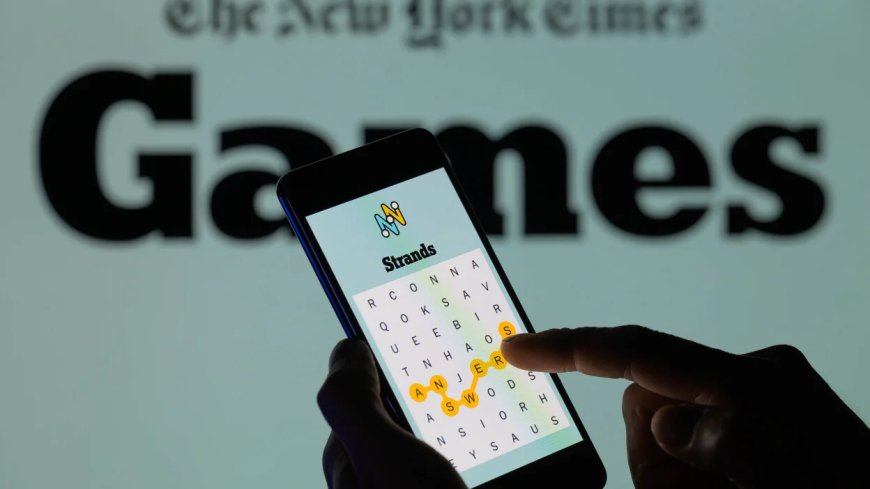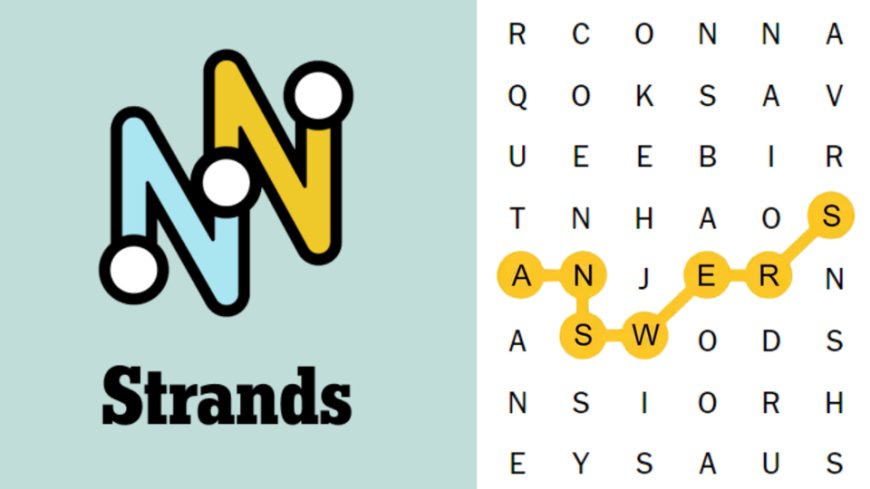How NYT Strands Hint Helped Me Solve the Toughest Puzzles
This composition, we'll dive deep into how nyt strands hint helped me break the toughest mystifications and elevate my game to a whole new position.

Preface
The New York Times (NNYT) Spelling Bee is one of the most popular and extensively loved word mystifications. With its simple format and engaging challenge, it appeals to both casual and deep mystification suckers. The ideal of the game is to produce as numerous words as possible from seven given letters, with one letter always having to be included. The addictive nature of the game, along with its rising difficulty, has made it a dependence for mystification solvers looking for a diurnal internal drill.
Still, if you’ve ever spent hours gaping at those putatively simple letters without changing the “pangram ”(a word using all the letters) or getting wedged right before the “genius” position, you are not alone. It turns out there is a tool within the NYT ecosystem that numerous seasoned players calculate on the nyt strands hint These subtle suggestions can give you the advance you need when you’re stumped.
Understanding the Spelling Bee Puzzle
The Basic Rules
Before diving into how the hints can enhance your game, let’s snappily review the mechanics of the NYT Spelling Bee.
Seven Letters. Each mystification provides seven letters, with one letter in the center. You must use the center letter in every word you produce.
Word Length. The words must be at least four letters long.
Pangrams. These are words that use all seven letters, and changing the pangram frequently gives you the most points.
Scoring. points are awarded based on the length of the word, with perk points for pangrams.
No Repeating Words. Plurals, proper nouns, and hyphenated words aren't allowed.
While the rules are straightforward, the difficulty ramps over quickly, especially when the letter combinations don’t feel to yield any egregious words.
The Challenge of Reaching Genius
Each spelling bee mystification has colorful ranking situations grounded on the number of words and points you accumulate. The rankings generally include
- Beginner
- Good Start
- Solid
- Nice
- Great
- Amazing
- Genius
The “genius” position is the ultimate emblem of honor for any spelling bee sucker, but reaching it can frequently feel like an uphill battle. On numerous occasions, I set myself one or two points down, frenetically searching for those last fugitive words.
This is where nyt strands hint came my secret armament.
nyt strands hint A Game-Changer
1. The slyness of Hints
Unlike direct answers or cheats, nyt strands hint offer subtle nudges in the right direction. These suggestions don’t give away the entire word but rather point you toward an implicit result without spoiling the challenge. The hints can include information similar to
The first letter of a word you haven’t set up yet.
The length of a word that’s missing.
The fact that there are composite words hidden within the mystification.
Whether you’re missing a plural form of a word or its verb form,.
These gentle prompts helped me develop my word-working chops rather than counting on brute force or outside help.
2. Learning to Fete Patterns
One of the most significant ways hints have bettered my spelling bee prowess is by tutoring me to fete letter patterns. Over time, I began to notice that certain letter combinations appear more constantly than others. For illustration
Common prefixes like “pre-," "con-," o “anti-” can frequently lead to longer words.
Suffixes like “-ing," ”-ed,""or “-er” can help extend a base word you’ve formerly discovered.
When certain letters, similar to Q, Z, or J, appear in the blend, the word possibilities become more technical.
Hints sometimes pushed me to explore these letter combinations when I was wedged, expanding my capability to see new possibilities within the constraints of the letters.
3. Breaking through Mental Blocks
Numerous times, when I was floundering to find further words, I’d realize that I was mentally wedged in a particular pattern. I might keep trying to produce words with a specific letter combination or suppose only of verbs when there could be plenty of nouns or adjectives still to discover. The hints helped me break through these internal blocks by reminding me that other types of words might still be in play.
For illustration, if the hint said I was missing a five-letter word starting with “S,”, I might realize I had been neglecting to consider adjectives and nouns starting with that letter. thisforbes

How nyt strands hint Improved My Overall Word Puzzle Chops
1. Developing a Flexible Mindset
Word mystifications, especially Spelling Bee, frequently bear inflexibility in thinking. Hints have trained me to approach the mystification with an open mind, always looking for different types of words (nouns, verbs, adjectives) and word forms (plural, singular, gerund). This has led to
Increased Vocabulary The spelling bee frequently uses words I’m strange with, but hints have led me to discover them, broadening my vocabulary in the process.
Side-allowing rather than being ray-concentrated on trying to break the mystification with a specific set of hypotheticals, I’ve learned to suppose more creatively, thanks to the gentle drives handed by the hints.
2. perfecting pattern recognition
Another crucial benefit is pattern recognition. Through harmonious play and the use of hints, I’ve honed my capability to identify common patterns in letter combinations, which is a skill that transcends the Spelling Bee mystification itself and has made me a better solver of other word-based mystifications, similar to crosswords and Scrabble.
For example, finding suffixes like-ing or-ment and prefixes like un- or dis- has helped me anticipate possible word combinations in the spelling bee.
3. Avoiding Frustration
Maybe one of the topmost benefits of using hints is the capability to avoid frustration. Getting stuck on a mystification can be demotivating, especially when you’re so close to reaching the “genius” position. The hints have saved me from abandoning mystifications, giving me just enough guidance to push through without feeling like I’m cheating.
Rather than losing initiative or interest, I’ve set myself up to be encouraged to continue working, learning further about word structure and possibilities along the way.
How to Use nyt strands hint Effectively
1. Do not calculate on Hints Too Early.
The key to using nyt strands hint is balance. You don’t want to lean on them too heavily, as that will rob you of the satisfaction of working the mystification on your own. rather, try to exhaust all your own ideas before turning to a hint.
tête-à-tête, I set myself a rule. I’m only allowed to check a hint after 20 twinkles of hitting a dead end. This gives me plenty of time to work through the mystification on my own, but the hint is there as a safety net if I need it.
2. Use Hints to Learn, Not Just Break
Rather than viewing hints as a roadway to the result, I approach them as a literacy tool.However, I’ll take the time to communicate possible words in my head rather than incontinently looking up answers if a hint suggests a five-letter word starting with a particular letter. This practice helps support word patterns and enhances my overall chops.
3. Reflect on What You Missed
After you’ve completed the mystification (especially if you had to calculate on multiple hints), take some time to reflect on the words you missed. Were there patterns you could have linked before? Were you stuck allowing a particular type of word, like verbs, while ignoring adjectives?
Reflecting on your missed words can help you become a further strategic solver in unborn mysteries.
The Joy of Discovery with NYT Spelling Bee
While the nyt strands hint have incontrovertibly helped me conquer some of the toughest mystifications, the real joy comes from the literacy process itself. The combination of challenge and subtle guidance has bettered my overall mystification-working capacities and has made every Spelling Bee bamboozle an occasion to learn commodity new.
For illustration, I’ve discovered obscure words like emmetropia (a medical term related to vision) and conus (a type of shell), which I would never have come across without Spelling Bee. The hints nudged me in the right direction, but the satisfaction of changing these words was all mine.
The NYT Spelling Bee is more than just a fun distraction; it’s a way to edge your mind, expand your vocabulary, and develop new problem-solving chops. By using hints as a tool for growth rather than a bolsterer, I’ve become a more confident and able solver, whether diving Spelling Bee, crosswords, or any other word mystification that comes my way.
Conclusion
A Winning Combination of Strategy and Support The New York Times Spelling Bee is a mystification that tests your vocabulary, creativity, and problem-solving capacities. While it can occasionally be a frustrating challenge, especially when you’re just a few points down from the genius position, the nyt strands hint offer the perfect balance of support without giving too much importance.
Using hints has not only helped me break the toughest mystifications but also converted me into a more thoughtful and strategic solver. By developing pattern recognition, learning to break through internal blocks, and staying flexible in my approach, I’ve turned frustrating roadblocks into openings for discovery and.
Also Read This Article: How Elon Musk and Donald Trump Approach Innovation and Disruption Differently



















